GetGhostGear.com
- Ghost
Hunting Gear, Tools and Equipment
For Sale!

Ghost Hunting
EMF Meter Comparison Table
ElectroMagnetic
Field Meters
directly or visit our
store of over 100 ghost hunting tools!
Shop for the latest EMF
meters below!
Single Axis EMF
Meter Store Page
Three Axis EMF
Meter Store Page
MultiFunction EMF
Meter Store Page
EMF Meter Package
Deal Store Page
OLD digg code HEREhttp://www.getghostgear.com/KnowledgeCenter/EMFmeterComparisonTable.htm
You are still on
GetGhostGear.com, we simply removed the normal navigation
to make the tables easier to read. This page contains several
tables set up as categories in a tree graph style. Start at the top of each
table and make one choice from the next line down to find the
meter you are interested in learning about.
At any point should you have questions about the terminology used,
please reference the superscript letter placed in
different colors
following the category heading. You will find the same letter,
phrase and colored letter following the table with additional
information and examples.
So what was our criteria for
the thumbs up or down? Well look at it from our perspective,
an
exploratory scientific investigator could perhaps be a more accurate
title for how we view a true paranormal investigator. We see
using the equipment listed on GetGhostGear.com going something like
this: Take readings in your investigation location, establish a
normal baseline over an extended period of time, watch data for
anomalies over another extended period of time, create testable
theories around average and anomalous data that could support
reported experiences, test those theories. That's it folks.
If the meter below got a thumbs down, most likely the data able to
be acquired from the equipment was not quantative enough to help
substantiate, disprove, or otherwise advance a logical and testable
theory.

|
ATTENTION: We
would avoid purchasing 98% of these meters for investigations
into reports of the paranormal. |
|
AC electromagnetic field Meters
A |
| Single Axis
B |
| Digital
C |
Analog
L |
|
Range Notification
D |
Numerical Display
H |
Range Notification
M |
Numerical Display
Q |
|
Lights
E |
Audible
F |
Both
G |
Lights
I |
Audible
J |
Both/Neither
K |
Lights
N |
Audible
O |
Both
P |
Lights
R |
Audible
S |
Both/Neither
T |
 |
 |
|
 |
|
|
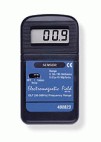 |
|
|
|
|
|
|
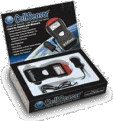 |
|
 |
|
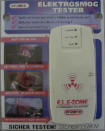 |
|
|
|
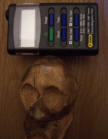 |
|
|
|
|
|
|
|
|
 |
 |
 |
 |
|
|
  |
|
|
|
|
|
|
  |
|
-----------------------------Advertise
Here-----------------------------
A
AC electromagnetic field Meters. Alternating Current
ElectroMagnetic Field Meters. Alternating currents are typically man made
such as over head and buried power lines, electrical wiring throughout buildings
and power outlets inside your home.
B
Single Axis. Refers to the
ability of the meter to monitor electromagnetic field from one single
direction at any one time.
C
Digital. Primarily refers to the type of display that shows what readings
the meters is receiving (think digital clock versus analog clock [the one with
hands]).
D
Range Notification. Apposed to an actual
display showing numbers this will give you a broad reading. For example, a
range of 10mg-30mg could be indicated to the user by the meter turning on a
certain color light or making a certain audible tone. To further the
example a reading of 30mg-50mg could trigger another light to turn on, or
another tone to sound.
E
Lights. Apposed to an actual display
showing numbers, this will give you a broad reading notifying you in the form of
illuminating a light on the meter. For example, a range of 10mg-30mg could
be indicated to the user by the meter turning on a certain color light. In
the case of there being multiple lights on the meter for a range of 30mg-50mg
one could expect a second light to turn on or the first light to change color.
There are even meters that will simply flash the same light in the presence of
any electromagnetic field. These are typically manufactured as just
notification devices and are not intended to be used to measure fields.
F
Audible. Same principle as the above
lights, except this time it is an audible notification. Apposed to an
actual display showing numbers or a needle pointing to a number, this will give
you a broad reading notifying you in the form of creating an audible sound from
the meter. For example, a range of 10mg-30mg could be indicated to the
user by the meter turning on an audible squelch tone. In the case of there
being multiple audible options on the meter for a range of 30mg-50mg one could
expect a new sound to turn on. There are even meters that will simply
create an audible tone in the presence of any electromagnetic field. These
are typically manufactured as just notification devices and are not intended to
be used to measure fields.
G
Both. These electromagnetic field meters have both light and
audible notifications built in to inform the user to a predetermined range of
electromagnetic fields being detected. These are typically manufactured as
just notification devices and are not intended to be used to measure fields.
H
Numerical Display. Apposed to previous
electromagnetic field
models in the table above, this type has an actual display showing numbers.
Typically showing in Milliguase or Tesla these numbers will be a specific
reading. There are a wide range of meters that fall into this category and
the buyer should beware. The metes in this category range from inexpensive
materials manufactured for health monitoring of general peak exposure limits to
that of more sophisticated computer interfaceable data logging. I have yet
to find a meter in this group that I wouldn't happily spend a few bucks more and
get many times more of a meter.
I
Lights. In this digital display category of
electromagnetic field meters you will not find a notification light (though I have asked my
manufactures for this). The light in this group will normally be an
inexpensive backlight display so you can more easily read the numbers in a low
light situation. I'll cut right to it, there aren't allot of
electromagnetic field meters in
this group that will give you a lighted display due to the manufacturing of them
being marketed towards very entry level customers. Again, there are
numerous electromagnetic field meters that you can purchase for just a few more dollars but that
have many additional options and a higher quality.
J
Audible. In this digital display category of electromagnetic field meters you will not find
a notification audible tone on many if any at all. I'll be frank here,
there aren't allot of electromagnetic field meters in this group that will give you a display and
an audible due to the manufacturing of them being marketed towards very entry
level customers. You can get these features on a three axis
electromagnetic field meter that
is offered in an analog housing on GetGhostGear.com, but not in a single axis
digital. Not to sound like a broken record but, there are numerous
electromagnetic field
meters that you can purchase for just a few more dollars but that have many
additional options and a higher quality.
K
Both/Neither. These electromagnetic field meters have both illuminated display and audible
notifications. A single axis, digital display with illumination and
audible notification. I just don't think they are currently being
manufactured. We carry this type of meter on GetGhostGear.com only in a
three axis analog format. Neither. Neither. There are also
enough meters in this category that do not have either as a standard option.
L
Analog. Primarily refers to the type of
display that shows what readings the meters is receiving. With these
meters think analog clock (the one with 'hands') versus digital clock.
M
Range Notification. Apposed to an actual
display showing numbers these would give a broad reading, if they actually
existed. I really don't think I have ever come across a manufacturer who
has taken the time to put in a needle but not specific numbers behind.
There are however several introductory models in this group that have analog
displays, that give specific number electromagnetic field readings that are not worth your money.
N
Lights. This group again, simply doesn't
have any being manufactured currently.
O
Audible. This group again, simply doesn't
have any being manufactured currently.
P
Both. This group again, simply doesn't have
any being manufactured currently.
Q
Numerical Display. Apposed to previous
electromagnetic field
models in the table above, this type has an actual display with a needle that
points to or hovers over numbers. Typically showing in Milliguase, Tesla,
or in many both at the same time. These numbers will be a specific
reading, no wimp out ranges here. There are a wide range of meters that
fall into this category so please do your research before you buy. The
meters in this group are normally created of inexpensive materials manufactured
for health monitoring of general peak exposure limits.
R
Lights. Great, now you can see your reading
in low light conditions. What can I say though, it is still a single axis.
Unless you have a specific theory you are working on hashing out, these single
axis electromagnetic field meters simply don't have the sophistication that we as independent
scientists need. Save your money until you have enough for a three axis
electromagnetic field
meter.
S
Audible. Great, now you can hear you have a
reading in low light conditions. What can I say though, it is still a
single axis. Unless you have a specific theory you are working on hashing
out, these single axis electromagnetic field meters simply don't have the sophistication that we
as independent scientists need. Save your money until you have enough for a
three axis electromagnetic field meter.
T
Both/Neither. Great, now you can see and hear you
have a reading in low light conditions. What can I say though, it is still
a single axis. Unless you have a specific theory you are working on
hashing out, these single axis electromagnetic field meters simply don't have the sophistication
that we as independent scientists need. Save your money until you have enough
for a three axis electromagnetic field meter. Neither. There are also enough meters in
this category that do not have either as a standard option.
*ElectroMagnetic Field Meters - *electromagnetic
field meters. No
accidental typos here, it should be stated that the SI
(International Standards) that oversees official unites of measurements
will hold "electromagnetic field" as an acronym for "electro motive
force."

|
ATTENTION: In
contrast to the table above, we
WOULD purchase 90% of these meters for investigations
into reports of the paranormal. |
|
AC electromagnetic field Meters
A |
| Three Axis
B |
| Digital
C |
Analog
L |
|
Range Notification
D |
Numerical Display
H |
Range Notification
M |
Numerical Display
Q |
|
Lights
E |
Audible
F |
Both
G |
Lights
I |
Audible
J |
Both/Neither
K |
Lights
N |
Audible
O |
Both
P |
Lights
R |
Audible
S |
Both/Neither
T |
| |
|
|
|
|
|
|
 |
|
|
|
|
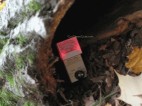 |
 |
|
 |
| |
|
|
|
|
|
|
 |
|
|
|
|
 |
 |
|
 |
-----------------------------Advertise
Here-----------------------------
A
AC electromagnetic field Meters. Alternating
Current ElectroMagnetic Field Meters. Alternating currents are
typically man made such as over head and buried power lines, electrical wiring
throughout buildings and power outlets inside your home.
B
Three Axis. Refers to the
ability of the meter to monitor electromagnetic field from three directions at
any one time.
C
Digital. Primarily refers to the type of display that shows what readings
the meters is receiving (think digital clock versus analog clock [the one with
hands]).
D
Range Notification. I can't
recall this category of electromagnetic field meters having any being manufactured currently.
The three axis equipment inside the meter typically keep them designed for the
higher end customer and thus have most additional features one would expect.
You will find these type of electromagnetic field meters in the single axis entry level groups.
But just for the record, apposed to an actual display showing numbers this will
give you a broad reading. For example, a range of 10mg-30mg could be
indicated to the user by the meter turning on a certain color light or making a
certain audible tone. To further the example a reading of 30mg-50mg could
trigger another light to turn on, or another tone to sound.
E
Lights. None that I'm aware of. The three
axis equipment inside the meter typically keep them designed for the higher end
customer and thus have most additional features one would expect. You will
find these type of electromagnetic field meters in the single axis entry level groups. But
just for the record, to an actual display showing numbers, this will give you a
broad reading notifying you in the form of illuminating a light on the meter.
For example, a range of 10mg-30mg could be indicated to the user by the meter
turning on a certain color light. In the case of there being multiple
lights on the meter for a range of 30mg-50mg one could expect a second light to
turn on or the first light to change color. There are even meters that
will simply flash the same light in the presence of any electromagnetic field.
These are typically manufactured as just notification devices and are not
intended to be used to measure fields.
F
Audible. I just don't think they
make them like this. The three
axis equipment inside the meter typically keep them designed for the higher end
customer and thus have most additional features one would expect. You will
find these type of electromagnetic field meters in the single axis entry level groups. But
just for the record, to an actual display showing numbers or a needle pointing
to a number, this will give you a broad reading notifying you in the form of
creating an audible sound from the meter. For example, a range of
10mg-30mg could be indicated to the user by the meter turning on an audible
squelch tone. In the case of there being multiple audible options on the
meter for a range of 30mg-50mg one could expect a new sound to turn on.
There are even meters that will simply create an audible tone in the presence of
any electromagnetic field. These are typically manufactured as just
notification devices and are not intended to be used to measure fields.
G
Both. Again, I don't think any
electromagnetic field meters
are being manufactured currently with these specifications. The three
axis equipment inside the meter typically keep them designed for the higher end
customer and thus have most additional features one would expect. You will
find these type of electromagnetic field meters in the single axis entry level groups.
H
Numerical Display. Apposed to
previous electromagnetic field models in the table above (D, E, F, & G), this type has an actual display showing
numbers. Typically showing in Milliguase or Tesla these numbers will be a
specific reading. Now we are starting to get somewhere. There are a wide range of meters that fall into this
category and the buyer should be aware of what they are looking to get from
their meter before they buy. You are stepping into the first category of
electromagnetic field meter that I would recommend (again, depending on your investigative goals).
You get a three axis monitoring meter, along with a specific number. What
this number being displayed is telling you can be very different between models
in this category. Some will be showing you a sum of the three axis's.
This type is basically giving you an average strength of the ElectroMagnetic
Field where ever the meter is placed. There are two other large variables
to be aware of with meters in this category and moving forward. The first
is what frequency they are set to monitor. By frequency I mean Alternating
Currents in the United States are set to around 60 hertz at 110 volts where as
European power is transferred at a frequency of 50 hertz at 220-240 volts.
What does this all mean to the person looking to start using equipment in their
paranormal investigations? What you need to be aware of is not all
electromagnetic field
meters have the same quality or capability of monitoring ElectroMagnetic Fields.
The frequency of the ElectroMagnetic Fields vary. If your meter is only
manufactured, or calibrated to monitor electromagnetic field in the frequency of 30 hertz to 70
hertz there are plenty of readings you are missing out on. Not only are
you missing out on this possibly important data, the information in a sum or
average setting on your meter is incomplete or at least requires being qualified
as such. As I discuss in
Paranormal Investigating Equipment 101,
if
you use your electromagnetic field meter only half correctly, the answers that you feel you are
divining are going to be incorrect. Lets move this example back one more
time. If you use your electromagnetic field meter 99.999% correct, your answers, your data,
your theory and general understanding of your investigative results in the
paranormal field will still be incorrect. You will be wrong. Do I
have your attention? If you are using scientific equipment, looking to
qualitatively back up your investigative findings then there is a steep learning
curve to reach that point. Just using this equipment doesn't make you a
scientist or scientific, it is truly the method and mindset that will eventually
make people call you a scientist. Most people who move forward with this
goal in mind attend a four year college for five or more years. Then they
receive an entry level position in some entry level job. After additional
years and decades in job experience they then are able to show a skill set that
might let them advance in a very narrow field. We striving to be
"independent scientists" typically have no such schooling, and no such job
experience. Not only that but we are moving ahead into an advance area of
research and experimental investigation that normally is populated with
scientists that have decades of experience. Where as the vast majority of
the scientists mentioned before move into an advance area of study, they also
move into an equally narrow field of study. We again, choosing to tackle
the paranormal reports must hold ourselves to an extraordinarily wide field of
study.
I
Lights. In this digital display
category of electromagnetic field meters you will not find a notification light (though I have
asked my manufactures for this). The light in this group will normally be
a backlight display so you can more easily read the numbers in a
low light situation.
J
Audible. In this digital display category of electromagnetic field meters you will not find
a notification audible tone on many though there popularity is growing.
K
Both/Neither. These electromagnetic field meters have both illuminated display and audible
notifications. A three axis, digital display with illumination and
audible notification is a big step in the right direction if you are willing to
learn the intricate ins and outs of it. We carry similar types of meters on GetGhostGear.com. Neither.
There are also enough meters in this category that do not have either as a
standard option.
L
Analog. Primarily refers to the
type of display that shows what readings the meters is receiving. With
these meters think analog clock (the one with 'hands') versus digital clock.
It has been my experience that analog displays are more sought after by the over
30 crowd and digital by the younger. I have heard from people complaining
about needle bounce on analog displays. This can be an issue easily
overcome by practiced methods ensuring it isn't an issue.
M
Range Notification. Apposed to an
actual display showing numbers these would give a broad reading, if they
actually existed. I really don't think I have ever come across a
manufacturer who has taken the time to put in a needle but not specific numbers
behind on a three axis electromagnetic field meter. There are however several introductory models in this group that
have analog displays, that give specific number electromagnetic field readings that are not worth
your money. Buyer beware of anything under $100 for an electromagnetic
field meter unless
you are doing specific theory focused research.
N
Lights. This group again, simply
doesn't have any being manufactured currently.
O
Audible. This group again, simply
doesn't have any being manufactured currently.
P
Both. This group again, simply
doesn't have any being manufactured currently.
Q
Numerical Display. Apposed to
previous electromagnetic field models in the table above, this type has an actual display with a
needle that points to or hovers over numbers. Typically showing in Milliguase, Tesla, or in many both at the same time. These numbers will be
a specific reading, no wimpy ranges here. The most prevalent meter in this
category is the TriField electromagnetic field meter that we carry many versions of on
GetGhostGear.com. We have been using this meter for over a decade in our
investigations, however it is one that has a marked learning curve. You
need to either have a good understanding of electrical principles or be willing
and able to learn them on your own.
R
Lights. Great, now you can see
your reading in low light conditions. The most prevalent meter in this
category is the TriField electromagnetic field meter that we carry many versions of on
GetGhostGear.com. The manufacturer even put in red LEDs so it would help
keep our night vision, cool right. We have been using this meter for over
a decade in our investigations, however it is one that has a marked learning
curve. You need to either have a good understanding of electrical
principles or be willing and able to learn them on your own.
S
Audible. Great, now you can hear
you have a reading in low light conditions. The most prevalent meter in
this category is the TriField electromagnetic field meter that we carry many versions of on
GetGhostGear.com. The squelch knob can be turned off two for those
situations where quite is best. We have been using this meter for over a
decade in our investigations, however it is one that has a marked learning
curve. You need to either have a good understanding of electrical
principles or be willing and able to learn them on your own.
T
Both/Neither. Great, now you can see and
hear you have a reading in low light conditions. The most prevalent meter
in this category is the TriField electromagnetic field meter that we carry many versions of on
GetGhostGear.com. The squelch knob can be turned off two for those
situations where quite is best. The LEDs can also be turned off to conserve
battery drain during the times when no extra light is needed. We have been
using this meter for over a decade in our investigations, however it is one that
has a marked learning curve. You need to either have a good understanding
of electrical principles or be willing and able to learn them on your own.
Neither. There are also enough meters in this category that do not have
either as a standard option.
*ElectroMagnetic Field Meters - *electromagnetic
field meters. No
accidental typos here, it should be stated that the SI
(International Standards) that oversees official unites of measurements
will hold "electromagnetic field" as an acronym for "electro motive
force."

| |
|
DC electromagnetic field Meters
A |
| Single Axis
B |
| Digital
C |
Analog
L |
|
Range Notification
D |
Numerical Display
H |
Range Notification
M |
Numerical Display
Q |
|
Lights
E |
Audible
F |
Both
G |
Lights
I |
Audible
J |
Both/Neither
K |
Lights
N |
Audible
O |
Both
P |
Lights
R |
Audible
S |
Both/Neither
T |
| |
|
|
|
|
|
|
|
|
|
|
|
|
|
|
 |
| |
|
|
|
|
|
|
|
|
|
|
|
|
|
|
  |
-----------------------------Advertise
Here-----------------------------
A
DC electromagnetic field Meters. Direct Current ElectroMagnetic Field Meters.
Direct currents (DC) are typically natural in origin such as
lightening, aurora borealis, and the fields created by the Earth
(most likely by the moving heavy metals in or around the core).
B
Single Axis. Refers to the
ability of the meter to monitor electromagnetic field from one single
direction at any one time. I don't mind this as much in the DC
electromagnetic field meter because on the higher end models they come with an
external probe that is very useful for monitoring and measuring the
different natural fields found everywhere on Earth.
C
Digital. Primarily refers to the type of display that shows what readings
the meters is receiving (think digital clock versus analog clock [the one with
hands]).
D
Range Notification.
Just Don't exist and if they do, I can't imagine they'd be of much
use for quantitative purposes.
E
Lights. Just
Don't exist and if they do, I can't imagine they'd be of much use
for quantitative purposes for the investigation of paranormal
reports.
F
Audible. Just Don't exist and if they do, I can't imagine
they'd be of much use for quantitative purposes.
G
Both. Just Don't
exist and if they do, I can't imagine they'd be of much use for
quantitative purposes.
H
Numerical Display. Apposed to previous
electromagnetic field
models in the table above, this type has an actual display showing numbers.
I
Lights. In this digital display category of
electromagnetic field meters you will not find a notification light (though I have asked my
manufactures for this). The light in this group will normally be a backlight display so you can more easily read the numbers in a low
light situation.
J
Audible. In this digital display category of electromagnetic field meters you will not find
a notification audible tone on many if any at all. I'll be frank here,
there aren't allot of electromagnetic field meters in this group that will give you a display and
an audible due to the manufacturing of them being marketed towards very entry
level customers.
K
Both/Neither. These electromagnetic field meters have both illuminated display and audible
notifications. A single axis, digital display with illumination and
audible notification. I just don't think they are currently
being manufactured.
Neither. There are also
enough meters in this category that do not have either as a standard
option.
L
Analog. Primarily refers to the type of
display that shows what readings the meters is receiving. With these
meters think analog clock (the one with 'hands') versus digital clock.
M
Range Notification.
Apposed to an actual display showing numbers these would give a
broad reading, if they actually existed. I really don't think
I have ever come across a manufacturer who has taken the time to put
in a needle but not specific numbers behind.
N
Lights. Just
Don't exist and if they do, I can't imagine they'd be of much use
for quantitative purposes for the investigation of paranormal
reports.
O
Audible. Just
Don't exist and if they do, I can't imagine they'd be of much use
for quantitative purposes for the investigation of paranormal
reports.
P
Both. Just Don't
exist and if they do, I can't imagine they'd be of much use for
quantitative purposes for the investigation of paranormal reports.
Q
Numerical Display. Apposed to previous
electromagnetic field
models in the table above, this type has an actual display showing numbers.
R
Lights. Great, now you can see your reading
in low light conditions. What can I say though, it is still a single axis.
Unless you have a specific theory you are working on hashing out, these single
axis electromagnetic field meters simply don't have the sophistication that we as independent
scientists need. Save your money until you have enough for a three axis
electromagnetic field
meter.
S
Audible. Great, now you can hear you have a
reading in low light conditions. What can I say though, it is still a
single axis. Unless you have a specific theory you are working on hashing
out, these single axis electromagnetic field meters simply don't have the sophistication that we
as independent scientists need. Save your money until you have enough for a
three axis electromagnetic field meter.
T
Both/Neither. Great, now you can see and hear you
have a reading in low light conditions. What can I say though, it is still
a single axis. Unless you have a specific theory you are working on
hashing out, these single axis electromagnetic field meters simply don't have the sophistication
that we as independent scientists need. Save your money until you have enough
for a three axis electromagnetic field meter.
Neither. There are also
enough meters in this category that do not have either as a standard
option.
*ElectroMagnetic Field Meters - *electromagnetic
field meters. No
accidental typos here, it should be stated that the SI
(International Standards) that oversees official unites of
measurements will hold "electromagnetic field" as an acronym for
"electro motive force."

|
ATTENTION: In
contrast, we
WOULD purchase 80% of these meters for investigations
into reports of the paranormal. |
|
DC electromagnetic field Meters
A |
| Three Axis
B |
| Digital
C |
Analog
L |
|
Range Notification
D |
Numerical Display
H |
Range Notification
M |
Numerical Display
Q |
|
Lights
E |
Audible
F |
Both
G |
Lights
I |
Audible
J |
Both/Neither
K |
Lights
N |
Audible
O |
Both
P |
Lights
R |
Audible
S |
Both/Neither
T |
| |
|
|
|
|
|
|
|
|
|
|
|
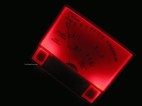 |
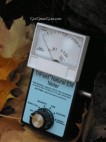 |
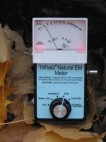 |
|
| |
|
|
|
|
|
|
|
|
|
|
|
 |
 |
 |
|
-----------------------------Advertise
Here-----------------------------
A
DC electromagnetic field Meters. Direct Current ElectroMagnetic Field Meters.
Direct currents (DC) are typically natural in origin such as
lightening, aurora borealis, and the fields created by the Earth
(most likely by the moving heavy metals in or around the core).
B
Three Axis.
Refers to the ability of the meter to monitor electromagnetic field
from three directions at any one time.
C
Digital. Primarily refers to the type of display that shows what readings
the meters is receiving (think digital clock versus analog clock [the one with
hands]).
D
Range Notification.
Just don't exist that I'm aware of. If they do they would
serve maybe as a life safety device worn to notify a person of high
DC electromagnetic fields. They would not be worth anything
for quantitative hard number data.
E
Lights. Just don't exist that I'm aware of. If they do
they would serve maybe as a life safety device worn to notify a
person of high DC electromagnetic fields. They would not be
worth anything for qualitative hard number data.
F
Audible. Just Don't exist and if they do, I can't imagine
they'd be of much use for quantitative purposes.
G
Both. Just don't exist
that I'm aware of. If they do they would serve maybe as a life
safety device worn to notify a person of high DC electromagnetic
fields. They would not be worth anything for qualitative hard
number data.
H
Numerical Display. Apposed to previous
electromagnetic field
models in the table above, this type has an actual display showing numbers.
I
Lights. In this digital display category of
electromagnetic field meters you will not find a notification light (though I have asked my
manufactures for this). The light in this group will normally be a backlight display so you can more easily read the numbers in a low
light situation.
J
Audible. In this digital display category of electromagnetic field meters you will not find
a notification audible tone on many if any at all.
K
Both/Neither. These electromagnetic field meters have both illuminated display and audible
notifications.
A three axis, digital display with illumination and audible
notification is a big step in the right direction if you are willing
to learn the intricate ins and outs of it. We carry similar
types of meters on GetGhostGear.com.
Neither. There are also
enough meters in this category that do not have either as a standard
option.
L
Analog. Primarily refers to the
type of display that shows what readings the meters is receiving. With
these meters think analog clock (the one with 'hands') versus digital clock.
It has been my experience that analog displays are more sought after by the over
30 crowd and digital by the younger. I have heard from people complaining
about needle bounce on analog displays. This can be an issue easily
overcome by practiced methods ensuring it isn't an issue.
M
Range Notification. Apposed to an
actual display showing numbers these would give a broad reading, if they
actually existed. I really don't think I have ever come across a
manufacturer who has taken the time to put in a needle but not specific numbers
behind on a three axis electromagnetic field meter. There are however several introductory models in this group that
have analog displays, that give specific number electromagnetic field readings that are not worth
your money. Buyer beware of anything under $100 for an electromagnetic
field meter unless
you are doing specific theory focused research.
N
Lights. This group again, simply
doesn't have any being manufactured currently. Which is fine as they would
not provide the detailed data in the form of actual number readings.
O
Audible. This group again, simply
doesn't have any being manufactured currently. Which is fine as they would
not provide the detailed data in the form of actual number readings.
P
Both. This group again, simply
doesn't have any being manufactured currently. Which is fine as they would
not provide the detailed data in the form of actual number readings.
Q
Numerical Display. Apposed to
previous electromagnetic field models in the table above, this type has an actual display with a
needle that points to or hovers over numbers. Typically showing in Milliguase, Tesla, or in many both at the same time. These numbers will be
a specific reading, no wimpy ranges here. The most prevalent meter in this
category is the TriField Natural electromagnetic field meter that we carry many versions of on
GetGhostGear.com. We have been using this meter for over a decade in our
investigations, however it is one that has a marked learning curve. You
need to either have a good understanding of electrical principles or be willing
and able to learn them on your own.
R
Audible. Great, now you can hear
you have a reading in low light conditions. The most prevalent meter in
this category is the TriField Natural electromagnetic field meter that we carry many versions of on
GetGhostGear.com. The squelch knob can be turned off two for those
situations where quite is best. We have been using this meter for over a
decade in our investigations, however it is one that has a marked learning
curve. You need to either have a good understanding of electrical
principles or be willing and able to learn them on your own.
S
Lights. Wonderful, you can see
your reading in low light conditions. The most prevalent meter in this
category is the TriField Natural electromagnetic field meter that we carry many versions of on
GetGhostGear.com. The manufacturer even put in red LEDs so it would help
keep our night vision, cool right. We have been using this meter for over
a decade in our investigations, however it is one that has a marked learning
curve. You need to either have a good understanding of electrical
principles or be willing and able to learn them on your own.
T
Both/Neither.
Both. Even better if you have both, now you can see and
hear you have a reading in low light conditions. The most prevalent meter
in this category is the TriField Natural electromagnetic field meter that we carry many versions of on
GetGhostGear.com. The squelch knob can be turned off two for those
situations where quite is best. The LEDs can also be turned off to conserve
battery drain during the times when no extra light is needed. We have been
using this meter for over a decade in our investigations, however it is one that
has a marked learning curve. You need to either have a good understanding
of electrical principles or be willing and able to learn them on your own.
Neither. There are also
enough meters in this category that do not have either as a standard
option.
*ElectroMagnetic Field Meters - *electromagnetic
field meters. No
accidental typos here, it should be stated that the SI
(International Standards) that oversees official unites of
measurements will hold "electromagnetic field" as an acronym for
"electro motive force."
Next Recommended
Op Ed -
electromagnetic field Meters 102
GetGhostGear.com
- Ghost
Hunting Gear, Tools and Equipment For Sale!

![]()























